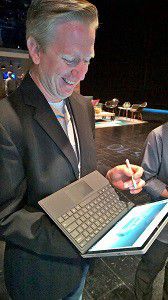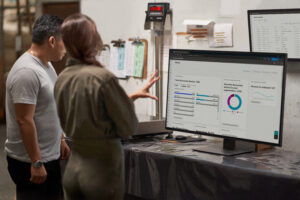Microsoft Surface suite: Powering the next wave of innovation for manufacturers
In my last blog, I explored the top Windows 10 features that can empower the manufacturing industry to be more productive, transform product design, and accelerate innovation. To support these new possibilities, Microsoft recently unveiled an exceptional portfolio of devices, including new Surface devices that unlock Windows 10 experiences.
Hardware to scale with your needs
To complement our popular Surface 3, we rolled out a progressive line of two new Surface products: Surface Pro 4 and Surface Book. These devices help you scale to meet the needs of your organization, whether you simply need a productivity device to use in the cloud, or you need the power to handle the largest assemblies, such as CAD software.
 First, our Surface 3 is a great low-cost solution for people who rely on cloud-based content. You can get a super light, but powerful computer that serves you well when you don’t need local processing, but you still need a productivity platform and access to engineering applications. As an example, it’s possible to virtualize your CAD application in the new Azure GPU Compute offering and access it from your browser whenever and wherever you have connectivity to the cloud.
First, our Surface 3 is a great low-cost solution for people who rely on cloud-based content. You can get a super light, but powerful computer that serves you well when you don’t need local processing, but you still need a productivity platform and access to engineering applications. As an example, it’s possible to virtualize your CAD application in the new Azure GPU Compute offering and access it from your browser whenever and wherever you have connectivity to the cloud.
Surface Pro 4 is 30 percent more powerful than Surface Pro 3 and is ideal for running mainstream CAD applications from companies like Siemens PLM Solid Edge, Dassault Systèmes SOLIDWORKS, and Autodesk Inventor. Siemens PLM’s latest version of Solid Edge, ST8, is a perfect example what’s possible when optimized for Surface 4 Pro: it includes touch-based gestures, pen interaction and of course, keyboard and mouse actions. And Surface Pro 4 is the fastest Surface ever adopted in business.
 With Surface Book, we have redefined the laptop with our very own high-performance computer that showcases what Windows 10 does best. And the industry is taking notice. Surface Book is perfect for those who need graphics and compute power but still want the Surface experience, such as the portability and long battery life of Surface 3, and the tablet that can run CAD with Surface Pro 4. Siemens PLM NX software is a great example of a high-powered application that takes advantage of all that Surface Book has to offer: the GPU, high DPI resolution, clipboard and creative canvas modes, touch and precision input as well as computing power.
With Surface Book, we have redefined the laptop with our very own high-performance computer that showcases what Windows 10 does best. And the industry is taking notice. Surface Book is perfect for those who need graphics and compute power but still want the Surface experience, such as the portability and long battery life of Surface 3, and the tablet that can run CAD with Surface Pro 4. Siemens PLM NX software is a great example of a high-powered application that takes advantage of all that Surface Book has to offer: the GPU, high DPI resolution, clipboard and creative canvas modes, touch and precision input as well as computing power.
So depending on your needs, there is a Surface that works well in your industry with the applications you need. Once you get to Surface Book, you can have cloud applications running, you can have local applications running, and you get great graphics and compute power that is operational—all at your fingertips.
Redefining the engineer’s workstation with Surface Book
 Let’s take a closer look at Surface Book. It is especially compelling for manufacturers because you can run the biggest, most powerful applications and stretch it to its maximum. Along with Surface Book’s touch-enabled screen, you can add two large 4K monitors, essentially giving you three screen areas from which to work—all from one device. When combined with Surface Dock, Surface Book is your new workstation that is also still mobile.
Let’s take a closer look at Surface Book. It is especially compelling for manufacturers because you can run the biggest, most powerful applications and stretch it to its maximum. Along with Surface Book’s touch-enabled screen, you can add two large 4K monitors, essentially giving you three screen areas from which to work—all from one device. When combined with Surface Dock, Surface Book is your new workstation that is also still mobile.
What makes Surface Book such a compelling device is its ability to support different work styles. You can run high-powered professional software and take advantage of the GPU when in laptop mode, and then detach the thin, light PixelSense screen, known as clipboard mode, and still take all of your compute power with you without the need to sync your files or keep a constant connection to the cloud. Surface Book’s PixelSense screen ratio is optimized for maximum display of ISO and ANSI paper sizes, meaning that digital document will render at full fidelity. The pen helps to markup documents or simply take notes. Furthermore, you can turn the screen around 180 degrees and attach it to the keyboard base so when folded down, the screen is upright and accessible. This is known as creative canvas mode, which provides great ergonomics for sketching with the pen. Apps can take advantage of the GPU and extra battery capacity as well. Everything is at your fingertips.
A hybrid workflow
 The Surface Book is designed to adapt to the way you work. The addition of the touch interface enables what I call a “hybrid workflow.” Rather than being forced to use touch or the keyboard/mouse exclusively, you can use them interchangeably as needed. It’s a more natural way of working because you can choose which interaction method works best for you. As an example, Siemens Solid Edge and NX CAD applications allow 3D navigation such as panning, zooming, and rotating with touch gestures, but also you can employ mouse button shortcuts or engage modes with a mouse click or keyboard shortcut. This level of flexibility means that you can work naturally and importantly, productively. If you have external monitors attached via the Mini Displayport or Surface Dock, Surface Book’s PixelSense screen is still available for use with touch controls and the pen, while the attached screens are accessible with a mouse. When used together, it’s a hybrid workflow and the ergonomics are superior, so you won’t get fatigued.
The Surface Book is designed to adapt to the way you work. The addition of the touch interface enables what I call a “hybrid workflow.” Rather than being forced to use touch or the keyboard/mouse exclusively, you can use them interchangeably as needed. It’s a more natural way of working because you can choose which interaction method works best for you. As an example, Siemens Solid Edge and NX CAD applications allow 3D navigation such as panning, zooming, and rotating with touch gestures, but also you can employ mouse button shortcuts or engage modes with a mouse click or keyboard shortcut. This level of flexibility means that you can work naturally and importantly, productively. If you have external monitors attached via the Mini Displayport or Surface Dock, Surface Book’s PixelSense screen is still available for use with touch controls and the pen, while the attached screens are accessible with a mouse. When used together, it’s a hybrid workflow and the ergonomics are superior, so you won’t get fatigued.
GPU for you
 There are two GPUs in the Surface Book: An Intel HD 520 processor in the ‘tablet’ for clipboard mode, which gives you the same power and performance as in some Surface Pro 4 models. When attached with the base keyboard, you then have a super powerful, discrete NVIDIA GeForce GPU at your fingertips, allowing you to harness the full power of hardware-accelerated graphics whether they are OpenGL or Direct3D based. Managing how and when the GPUs can be used is at your discretion too. You can assign a GPU to the application or set a default. When and why you would choose a specific GPU depends on how you work. If you detach the PixelSense screen often, then choosing the Intel HD 520 will allow seamless transitions to and from the clipboard mode. If you find that you detach less often, then choosing the NVIDIA GPU is likely to be a better choice. Of course, if you work interchangeably, then Windows 10 will manage the GPU assignment for you. If your application is currently using the NVIDIA GPU, and you need to detach, Windows 10 will ask that you close the application to free the dependency on the base. In fact. it withholds the detach request to prevent any accidental data loss.
There are two GPUs in the Surface Book: An Intel HD 520 processor in the ‘tablet’ for clipboard mode, which gives you the same power and performance as in some Surface Pro 4 models. When attached with the base keyboard, you then have a super powerful, discrete NVIDIA GeForce GPU at your fingertips, allowing you to harness the full power of hardware-accelerated graphics whether they are OpenGL or Direct3D based. Managing how and when the GPUs can be used is at your discretion too. You can assign a GPU to the application or set a default. When and why you would choose a specific GPU depends on how you work. If you detach the PixelSense screen often, then choosing the Intel HD 520 will allow seamless transitions to and from the clipboard mode. If you find that you detach less often, then choosing the NVIDIA GPU is likely to be a better choice. Of course, if you work interchangeably, then Windows 10 will manage the GPU assignment for you. If your application is currently using the NVIDIA GPU, and you need to detach, Windows 10 will ask that you close the application to free the dependency on the base. In fact. it withholds the detach request to prevent any accidental data loss.
Surface in action
 Local Motors is a great example of a company that is improving productivity and accelerating product engineering with our Surface suite. Mobile workers who need to be on the factory floor, onsite with a customer, or at the proving grounds for vehicles testing, are using Surface Pro 3s. For these employees, their desktop is their tablet, where they can run all their core applications. Everything is synced up, so they can work exactly where they need to be with zero downtime moving from their desktop to offsite. This is where Surface Pro 3 really shines. Then Local Motors engineers are using the advanced capabilities of Surface Pro 4 to have more flexibility in how and where they work. So they don’t have feel like they have to be at their desk all day, but still have the power they need whether they are working from home or are with a supplier onsite. It’s truly a seamless experience and Local Motors sees this as an exciting new way of working.
Local Motors is a great example of a company that is improving productivity and accelerating product engineering with our Surface suite. Mobile workers who need to be on the factory floor, onsite with a customer, or at the proving grounds for vehicles testing, are using Surface Pro 3s. For these employees, their desktop is their tablet, where they can run all their core applications. Everything is synced up, so they can work exactly where they need to be with zero downtime moving from their desktop to offsite. This is where Surface Pro 3 really shines. Then Local Motors engineers are using the advanced capabilities of Surface Pro 4 to have more flexibility in how and where they work. So they don’t have feel like they have to be at their desk all day, but still have the power they need whether they are working from home or are with a supplier onsite. It’s truly a seamless experience and Local Motors sees this as an exciting new way of working.
Tech Specs
There are some impressive specs that make the Surface Book just right for manufacturers:
High powered GPU: The NVIDIA GeForce GPU has 1G of dedicated high speed memory.
Graphics and resolution: Screen resolution is 3000 X 2000 pixels, giving you a big, beautiful 13.5-inch screen with incredible pixel density and highest DPI—up to 267—with improved latency and parallax.
Processor: The Intel Core i7 chip with 16GB of RAM is the optimal configuration for running CAD software.
Battery life: Surface Book packs a lot of battery life into a small device: 10 hours, similar to Surface Pro 4.
Connectivity: Two high speed USB ports, a single mini display port, and a full size SD port are all features that manufacturers will appreciate.
 Unparalleled Design: Microsoft uses Surface to design Surface. A lot of care and attention went into every detail of the design, from the glass trackpad, to the backlit keyboard, to the magnesium alloy body, to the superior design of the fulcrum hinge.
Unparalleled Design: Microsoft uses Surface to design Surface. A lot of care and attention went into every detail of the design, from the glass trackpad, to the backlit keyboard, to the magnesium alloy body, to the superior design of the fulcrum hinge.
I encourage you to redefine the way you and your teams work with these versatile devices—they are the next wave of technology innovation to bring power and productivity to your engineers, designers, and field teams. Learn more here.




